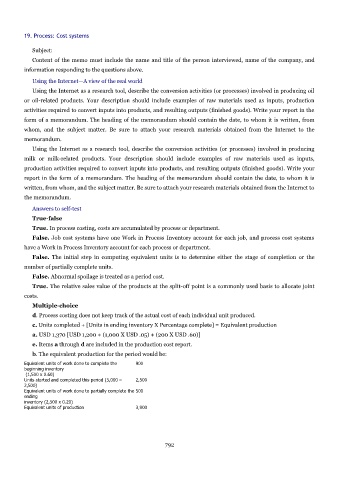Page 791 - Accounting Principles (A Business Perspective)
P. 791
19. Process: Cost systems
Subject:
Content of the memo must include the name and title of the person interviewed, name of the company, and
information responding to the questions above.
Using the Internet—A view of the real world
Using the Internet as a research tool, describe the conversion activities (or processes) involved in producing oil
or oil-related products. Your description should include examples of raw materials used as inputs, production
activities required to convert inputs into products, and resulting outputs (finished goods). Write your report in the
form of a memorandum. The heading of the memorandum should contain the date, to whom it is written, from
whom, and the subject matter. Be sure to attach your research materials obtained from the Internet to the
memorandum.
Using the Internet as a research tool, describe the conversion activities (or processes) involved in producing
milk or milk-related products. Your description should include examples of raw materials used as inputs,
production activities required to convert inputs into products, and resulting outputs (finished goods). Write your
report in the form of a memorandum. The heading of the memorandum should contain the date, to whom it is
written, from whom, and the subject matter. Be sure to attach your research materials obtained from the Internet to
the memorandum.
Answers to self-test
True-false
True. In process costing, costs are accumulated by process or department.
False. Job cost systems have one Work in Process Inventory account for each job, and process cost systems
have a Work in Process Inventory account for each process or department.
False. The initial step in computing equivalent units is to determine either the stage of completion or the
number of partially complete units.
False. Abnormal spoilage is treated as a period cost.
True. The relative sales value of the products at the split-off point is a commonly used basis to allocate joint
costs.
Multiple-choice
d. Process costing does not keep track of the actual cost of each individual unit produced.
c. Units completed + [Units in ending inventory X Percentage complete] = Equivalent production
a. USD 1,370 [USD 1,200 + (1,000 X USD .05) + (200 X USD .60)]
e. Items a through d are included in the production cost report.
b. The equivalent production for the period would be:
Equivalent units of work done to complete the 900
beginning inventory
(1,500 x 0.60)
Units started and completed this period (5,000 – 2,500
2,500)
Equivalent units of work done to partially complete the 500
ending
inventory (2,500 x 0.20)
Equivalent units of production 3,900
792

